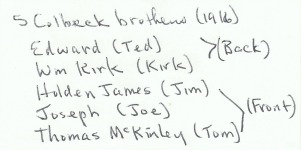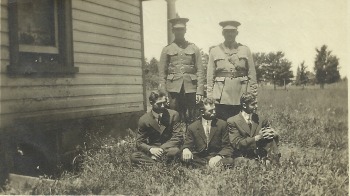- Home
- Research
- Preserve information
- Preserving information details
Preserving Your Information Details
The Specifics of How To Save Your Genealogy Data
Preserving your information details aids you to make certain you never lose your information again.
Before taking a photograph, place the source page with the information page so your photo will have all the source information right with the photograph.


If you are using a digital camera, this produces an exact copy of the original on your camera's memory card for easy transfer to your computer either now or later.
If you are using a film camera, you have an exact copy on the film which you will later develop. It is not a digital image. If you want to make it a digital image, you will later have to scan the negative or the print.
You may be asked to turn off the flash on your camera in photographing documents. Flash can harm certain papers and photographs, so be certain you follow the instructions carefully.
Remember when taking your photographs that you are limited in how many you can make, either by the amount of film you have, or by the capacity of your camera's memory card, the colour depth and resolution of your settings, and whether you have additional camera memory cards you can use if you fill up the first one. You may also have a memory card reader with your notebook computer with you so you can dump the digital images from the cards to your computer.
Return to Ways to Preserve Your Data
If you cannot photograph, videotape, photocopy, or print from the microfilm/fiche machines, you can still probably record it by reading the material into a microcassette recorder. This is not the optimal method to preserve your information. Sometimes it is the only way. It is certainly better than doing nothing!
In this case you end up with a spoken audio file containing exactly what you spoke into the recorder. It may or may not be entirely exact depending on how accurately you read the material.
Don't forget also to record all the source information for each information page you are audio-recording. Be sure to include all the information. You may want to write it down first so you can record it with the page to be certain you do not omit any source information.
Also, it is much more difficult to do an audio recording for a visual document such as a photograph than it is to read from a page containing only words.
Return to Ways to Preserve Your Data
This gives a paper copy directly from the original.
Again, make yourself a source page with all the relevant information and photocopy it with the genealogy information you found. You can also simply letter the source information on the document, either on the front if there is room, or on the reverse of the page.
Also, if you have not used this model of photocopy machine before, and you face a big choice of buttons, paper size, orientation, single or duplex copies, collation, and, perhaps, even stapling, you may want to ask for assistance for the first few copies.
You will also have to pay a per-page fee to photocopy your materials so make good copies on your first try. It saves you money, and it saves the trees!
Return to Ways to Preserve Your Data
This gives you a hard copy directly from the original fiche or microfilm, and helps to prevent any errors. It is, of course, only usable where the material has been filmed or fiched.
Using the microfilm/microfiche printer can be tricky if you have never done it before. Don't be afraid to ask the staff at the facility for help. Most people find the hardest part is to make certain that the print they make includes the entire page or portion of the document they wish to preserve. It is very easy to cut off a side or the bottom of the page you are printing. Remember, you are making certain you preserve your information, so you want to be certain you have it all.
Making prints of the page from a microfilm/microfiche reader usually costs some charge per page. After all, the facility is providing the material (which they likely had to buy), maintaining the machines (servicing costs money), and keeping the printer supplied with copy/printer paper. Since each print costs money, you want to make certain you get a good copy the first time.
There is no way for you to attach the source information to the film or fiche before you print it from the machine.
Letter all the source information on a piece of paper. Let's call that the source page. As soon as you have finished printing the information copy from the microfilm/microfiche machine, take that paper copy to the photocopy machine, place it with the source page, and make a copy of it. If there is no room on the front of the microfilm/microfiche machine copy, then make a copy of the plain white back of it with the source page placed there. You could also simply letter the source information on the back of the page. This assures that the two pieces, the original information and the source information, remain permanently attached to each other.
Return to Ways to Preserve Your Data
Scans produce a copy directly from the original, but some machines can produce either a printed copy or a digital file. The scanner may belong to the repository, or it may be a small pen scanner you bring with you which scans a line at a time onto your computer.
If the scanner is a model you have never seen before, or if you are using it for a purpose you have never used a scanner before (making a copy of a color transparency, for instance), ask for help. Remember there will likely be a fee for the copy, especially if you print it.
Be certain to attach the source page to the genealogy information before you scan it, or letter the source information on the scanned page. Remember, your aim is to be certain all the source information for this particular genealogy information is permanently attached to this copy.
If you use a pen scanner or other small hand-held model, you will scan lines or columns at a time rather than the total page. For instance, a pen scanner has memory in it, and your line by line image goes into it as a digital image which you can then take to your computer and load into whatever digital imaging program you use
This is a relatively newer way to preserve your information - make certain you know how to use it properly. Practice with it at home so you feel comfortable with it.
Because the pens are small, they do not have the capacity of a large hard drive for storing the digital images. It is rather like using a digital camera. The number of documents you can scan will be limited by the capacity of the memory in the pen scanner.
Return to Ways to Preserve Your Data
This produces a written copy. Again, be very careful not to introduce errors. The accuracy of the copy you are preserving is only as good as your ability to be exact in writing down the information. Also, transcribing data to preserve the information in a photograph is a much more difficult task.
In this case you are writing the information down on paper, so be certain also to write all the source information for each copy.
Return to Ways to Preserve Your Data
As above with still photos, be certain to place the source information with the genealogy information you are videotaping so it will all be permanently kept together. If you cannot place the source page on the information page without covering some of the genealogy information you are copying, place the source page by itself. Then videotape the source page followed by the information page.
Many of the same caveats apply here as with the camera above. You either have a digital image stored on a compact disc or memory card in your video camera, or an image on tape (film) to be developed later.
Also, you may not be able to use lights with your video camera. Be prepared for that. Figure out what you will do if you cannot use the video camera without the lights because the room is too dark. Do this before you leave home.
Return to Ways to Preserve Your Data
It's All in the Details!
Free Newsletter!!!
Find new tips and tricks here - new sources to check out
Click here to sign up for Genealogy Gems
I promise to use your email to send only the newsletter.
And if you ever decide to discontinue it, every issue has a form for stopping the newsletter.
How there's so much free information on this site ...
I have some affiliate links on this website. If you buy a product through them I receive a small commission at no extra cost to you. This helps keep the site free of charge.
To learn more, see my affiliate disclosure document.
Free Newsletter!!!
Find new tips and tricks here - new sources to check out
Click here to sign up for Genealogy Gems
I promise to use your email to send only the newsletter.
And if you ever decide to discontinue it, every issue has a form for stopping the newsletter.
How there's so much free information on this site ...
I have some affiliate links on this website. If you buy a product through them I receive a small commission at no extra cost to you. This helps keep the site free of charge.
To learn more, see my affiliate disclosure document.